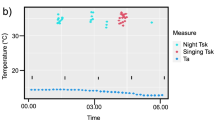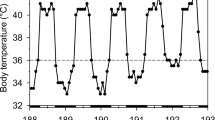Summary
Tibicen chiricahua and T. duryi are cicada species that are active as adults early each summer in central New Mexico, and are often syntopic in pinyon-juniper woodlands. Both species regulate thoracic temperature (Tth) within fairly narrow limits by utilizing behavioral mechanisms and evaporative cooling. However, syntopic populations of these two species were found to regulate at different Tth despite having synchronous annual and daily activity periods; overall mean Tth of T. chiricahua was 3.1°C higher than it was for T. duryi. Interspecific differences in evaporative cooling abilities and rates of passive heat exchange could not account for this difference in Tth. Part of the difference in Tth resulted from the fact that individuals of the two species were active in thermally distinct microhabitats. Within each species, mean Tth varied among behavior categories, and differences in how the two species allocated their time between activities also contributed to the interspecific difference in Tth. Though T. duryi is restricted to pinyon-juniper habitats such as the one in this study, T. chiricahua is also found in warmer habitats. The difference in Tth in the syntopic populations probably reflects interspecific differences in thermal preferences and thermal optima that are adaptive over their respective habitat ranges. The degree of dependence of Tth on ambient temperature (Tam) varied between activities within both species, with the least dependence exhibited during singing. Singing involves intense activity of tymbal muscles, which apparently can only function effectively over a relatively narrow range of temperature.
Similar content being viewed by others
References
Bartholomew GA, Heinrich B (1978) Endothermy in African dung beetles during flight, ball making, and ball rolling. J Exp Biol 73: 65–83
Casey TM (1976) Activity patterns, body temperature and thermal ecology in two desert caterpillars (Lepidoptera: Sphingidae). Ecology 57: 485–497
Chappell MA, Bartholomew GA (1981) Standard operative temperatures and thermal energetics of the antelope ground squirrel Ammospermophilus leucurus. Physiol Zool 54: 81–93
Dreisig H (1980) Daily activity, thermoregulation and water loss in the tiger beetle, Cicindela hybrida. Oecologia 44: 376–389
Hastings JM (1989) Thermoregulation in the dog-day cicada Tibicen duryi (Homoptera: Cicadidae). Trans Ky acad Sci 50(3–4): 145–149
Heath JE (1967) Temperature responses of the periodical “17-year” cicada, Magicidada cassini (Homoptera: Cicadidae). Am Midl Nat 77: 64–76
Heath JE, Wilkin PJ (1970) Temperature responses of the desert cicada, Diceroprocta apache (Homoptera: Cicadidae). Physiol Zool 43: 145–154
Heath JE, Hanegan JL, Wilkin P, Heath MS (1971) Adaptation of the thermal responses of insects. Am Zool 11: 147–158
Heinrich B (1972) Energetics of temperature regulation and foraging in a bumblebee, Bombus terricola Kirby. J Comp Physiol 77: 49–64
Heinrich B (1977) Why have some animals evolved to regulate at a high body temperature? Am Nat 111 (980): 623–640
Heinrich B (1981) Insect thermoregulation. John Wiley & Sons, New York. 328 pp
Huey RE, Slatkin M (1976) costs and benefits of lizard thermoregulation. Quart Rev Biol 51: 363–384
Huey RB, Stevenson RD (1979) Integrating thermal physiology of ectotherms: A discussion of approaches. Am Zool 19: 357–366
Josephson RK, Young D (1979) Body temperature and singing in the bladder cicada, Cystosoma saundersii. J Exp Biol 80: 69–81
Kaser SA, Hastings JM (1981) Thermal physiology of the cicada Tibicen duryi. Am Zool 21: 1016
Mac Nally RC, Doolan JM (1982) Comparative reproductive energetics of the sexes in the cicada Cystosoma saundersii. Oikos 39: 179–186
SAS Institute (1985) SAS user's guide: Statistics, Version 5 Ed. SAS Institute, Inc., Cary, NC
Stevenson RD (1985) The relative importance of behavioral and physiological adjustments controlling body temperature in terrestrial ectotherms. Am Nat 126: 362–386
Toolson EC (1984) Interindividual variation in epicuticular hydrocarbon composition and water loss rates of the cicada Tibicen dealbatus (Homoptera: Cicadidae). Physiol Zool 57: 550–556
Toolson EC (1987) Water profligacy as an adaptation to hot deserts: water loss rates and evaporative cooling in the sonoran Desert cicada, Diceroprocta apache (Homoptera: Cicadidae). Physiol Zool 60: 379–385
Author information
Authors and Affiliations
Rights and permissions
About this article
Cite this article
Hastings, J.M., Toolson, E.C. Thermoregulation and activity patterns of two syntopic cicadas, Tibicen chiricahua and T. duryi (Homoptera: Cicadidae), in central New Mexico. Oecologia 85, 513–520 (1991). https://doi.org/10.1007/BF00323763
Received:
Accepted:
Issue Date:
DOI: https://doi.org/10.1007/BF00323763




